Last month, Lowimpact.org’s Sophie Paterson, a trainee with the School of Natural Building, took a hands-on approach learning how to construct recycled car tyre foundations on a Straw Works course at Holy Trinity Church in Tulse Hill, London.
Inspired by the rise of earthships as a construction method, car tyre foundations were pioneered in the UK by Barbara Jones of Straw Works, who successfully secured building control approval from Calderdale Council in 1998. Designed to be cement free, they can represent a viable and affordable alternative for self-builders and community groups alike – with a bit of hard graft, of course!
So how do car tyre foundations work? The recycled but undamaged tyres are built upwards in pillars from levelled subsoil and are generally filled with self-draining pea shingle. The non-porous nature of both the tyres and the gravel removes the need for the damp-proof course typical in cement foundations. Tyres exposed above the final ground level must be protected from UV light to minimise potential for degradation, either by using a special paint or a suitable covering, such as a woven willow frame or cladding.
But, I hear you say, car tyres aren’t exactly a natural material, are they? And don’t they give off lots of nasty gases? It’s certainly true that car tyres are far from a “natural” material. For some, this in itself may rule them out as a solution for a natural building project, opting instead for gravel or rubble trench foundations. As for the potential for leaching toxic chemicals, concerns have been raised in tandem with the rise in popularity of earthships and even growing vegetables in recycled car tyre stacks.
Addressing this issue, Mischa Hewitt of Brighton Permaculture Trust writes here that, whilst further research may be required: “(t)he solution is to isolate the tyres from anything that can degrade them, and remove pathways for contaminants. So if they’re used in a way that’s inert, e.g. damp-proofed and rendered to protect them from sunlight and water, they shouldn’t really a problem.” This is again why it is necessary to suitably protect any tyres above ground level as described above. Further discussion about the potential for off-gassing can be found here, here and here. Despite the apparent uncertainty, with the UK producing a staggering 55 million waste tyres each year, there is arguably a case to be made for finding viable ways to re-use some of them.
So what about the cost of using car tyres for foundations? Opting for car tyre foundations can represent a significant potential financial saving at point of build. Tyres can often be sourced for free, meaning total costs are potentially in the hundreds rather than the thousands of pounds common to concrete foundations. The foundations for a three bedroom single-storey straw bale house built by Straw Works in 2011 cost a mere £500, which included the cost of hiring a digger.

Having achieved widespread acceptance throughout the UK, car tyre foundations reached another milestone in March 2017. With a team of volunteers, Straw Works undertook plate tests at the Holy Trinity Tulse Hill site pictured above. It’s set to be Europe’s first straw bale church building and London’s largest straw bale building to date. The tests revealed that a stack of tyres filled with pea shingle showed a mere 3mm of movement under 1000 kiloNewtons per square metre (100 tons) of pressure. There was no detectable movement when testing for expansion. These truly remarkable results means the proposed foundations, sitting on London clay, will easily accommodate the 700 kN/sqm pressure predicted to be exerted by the building.
Most impressive of all, however, is the accessibility of the method. This was evident throughout the course I attended continuing foundation works at Holy Trinity Tulse Hill. Led by Barbara, participants ranged in age from their teens to their eighties, something of a rarity on most building sites! Some of us had prior experience, some of us no experience at all, but we all shared a great deal of enthusiasm and energy. Crucially, we needed no overly-technical tools or instruments, mainly just our hands, sometimes our feet and always a good helping of common sense.
It was a unique learning opportunity in terms of the team and also the tyres we were using: in a first for Barbara too, the very first layer used not car tyres but recycled tractor tyres! After working with these monsters, moving on to work with standard car tyres seemed that little bit less daunting. The spring sunshine undoubtedly helped, too. You can see the team at work in the time-lapse video below, created by fellow course participant and School of Natural Building trainee, Harriette Warner.
One of the most significant lessons I came away with was the importance of measuring, re-measuring and measuring again, ideally with a second and even third pair of eyes to verify. The smallest of errors at the foundations stage could have real implications for the remainder of the build – and once a tractor tyre is full to the brim with pea shingle, moving it is not an attractive prospect! Working in teams of two, we also learnt how to accurately use a water level, using a central datum as a reference point. The step of the main church building provided the ideal solution in this case, with each of us regularly checking the level of our stack of tyres against this.
In all, the spirit and energy of the course participants and volunteers was truly infectious, fuelled by the absolute commitment of the church congregation, led by Vicar Richard Dormandy. The entire project is testament to the power of everyday people who, once equipped with the skills and knowledge, are more than capable of realising their ambitions to build for themselves in community. As for me, I came away with a deeper understanding of the construction process and the knowledge that car tyre foundations could represent an affordable option for some self-build projects.

If you’re interested in learning more about car tyre foundations, full technical details are available for free from Straw Works, who offer regular training opportunities specialising in straw-bale construction. Meanwhile, you can follow progress of the project at Holy Trinity Tulse Hill by following Vicar Richard Dormandy on Twitter.

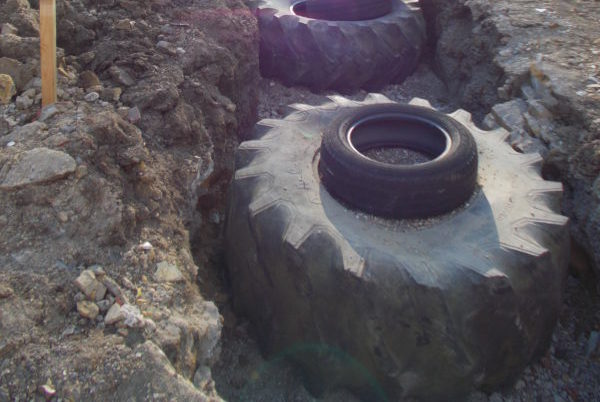
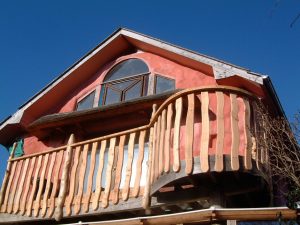
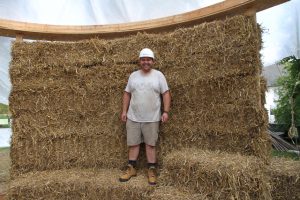

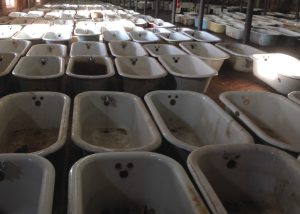
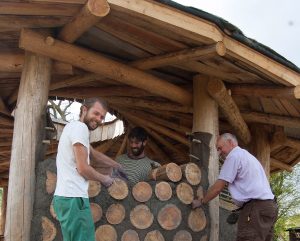
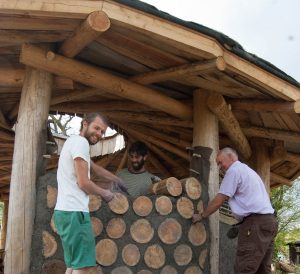
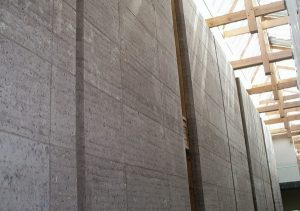
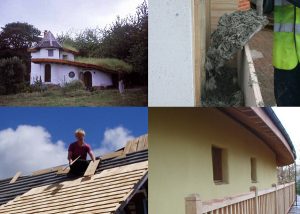

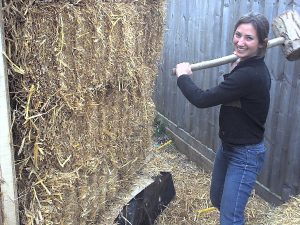
12 Comments
Interesting, thanks. I have looked at this topic before and would like to know more. I have a question:
In paragraph 3 you say that the shingle in-fill is non-porous. This is the wrong choice of word, isn’t it? Shingle obviously lets water through, so how does the structure stop rising damp?
Andrew
I think it means that neither the gravel nor the tyres will wick moisture up (although the shingle will let water pass through it via gravity), hence no need for a damp course.
Sophie, is that right?
Hi Dave and Andrew,
My understanding is that the pea shingle is in itself a non-porous material but that, in formation within the tyre pillar, it is the very tiny gaps that exist between the stones (even when packed tightly into the tyre) that enable water to travel downwards by the action of gravity.
In terms of water travelling upwards from the ground, the pea shingle (usually 10mm/½”) acts as a capillary break, whereby the compacted layer of stones have spaces between them which are too large for water to move upwards through the pillar via capillary action. This effectively ensures that moisture is prevented from entering a building via the earth yet provides a way in which moisture that has entered from above can drain away. The rising damp problems inherent in modern buildings using cement foundations are due to the fact that cement does attract moisture to itself and thus requires the use of a plastic damp proof course (a whole other issue in itself!).
For further information and instructions as to how to build car tyre foundations, see Appendix 5 of Building with Straw Bales (4th ed.) by Barbara Jones.
Hello,
Ive just been reading this thread, in preparation for using rammed tyres for foundations to a garden cabin.
Gravel is still a finite material, so not entirely a sustainable product. What do people think about using recycled aggregate/crushed concrete to ram the tyres with? The only concern that recycled aggregate/crushed concrete will draw or hold moisture. Any thoughts?
Can I ask why the accompanying technical document suggest sheep’s wool for the main slab insulation? Nothing against sheep, I am just curious why they didn’t use straw bales. Many thanks.
@IainSwanston Thanks for your query. My understanding is that straw bales wouldn’t be the most appropriate choice in this particular case, due primarily to the dimensions at play. 250mm is a significantly smaller depth than that of the standard building bale (usually 365mm/14″) so either an extensive customisation of the bales would be required or an increase of the depth of the floor. Neither would be ideal in this case, hence the preference for sheep’s wool, which offers a lighter and less labour-intensive alternative. However, I am aware of straw bales being used for insulation purposes in floors and between rafters, but it is not recommended for certain areas, such as a bathroom, due to increased risk of water leaks. Of course, all of that said, choice of insulation will always depend on a variety of factors, from budget to availability of materials and time pressures, meaning one might be preferable over another and vice versa according to different circumstances. I hope this helps a little in this case, though.
@MarkDenson Sincere apologies that I managed to miss your earlier comment. The crucial quality of the gravel is that it is free-draining, whereas concrete could both draw and retain moisture to the point of saturation, as you say, which would certainly be far from ideal in terms of foundations. So a definite thumbs down for concrete, even if recycled, I’m afraid.
Hi Sophie, I am located in Kenya and am looking at using a tyre foundation on a raised murrum compacted surface ontop of black cotton soil. to build a classroom made of ecobricks
Do you have any suggestions on how best to do this?
In my opinion, it is good to see the many types of effort it takes to rid the world of waste tyre problems. I have been in the industry for 50 years now and am always interested in new methods of tyre disposal, including yours. Well done.
https://admin.tyresandservice.co.uk/fittingcentre/cms/edit/e68997b1-841e-4971-8268-8614129e4dab/content
n my opinion, it is good to see the many types of effort it takes to rid the world of waste tyre problems. I have been in the industry for 50 years now and am always interested in new methods of tyre disposal, including yours. Well done.
https://www.pellontyres.co.uk/c/a-waste-car-tyre-to-tarmac-story
Sorry but i entered the wrong link on the previous comment of mine ?
Hi Sophie, I think you misunderstand what crushed concrete is. It is recycled concrete that has been crushed down to tiny bit la – like gravel. This instead of dredging gravel from the bottom of the sea, we can reuse the concrete taken out of demolitions our buildings. On reflection, I guess this is more of a suggestion than a question.
Non porous means water can’t get through.
Porous means water can get through.
Hi there, I am really curious about this project. So did the end project get completed- the new build?
Thanks 🙂